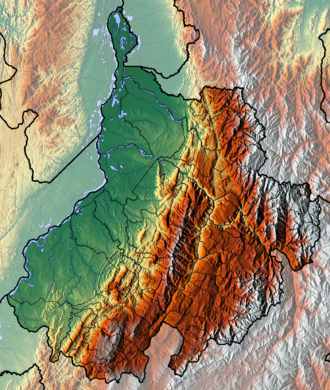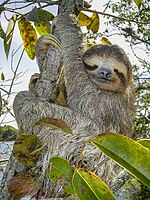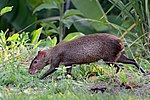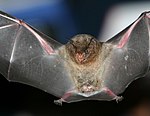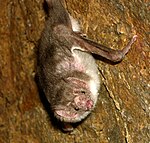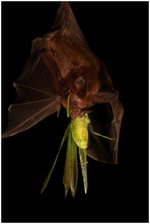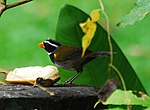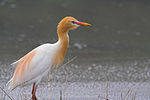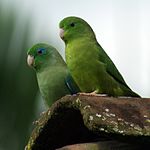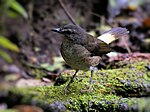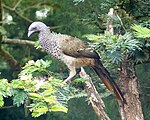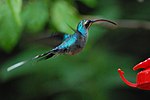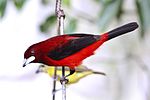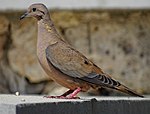|
Lebrija River
Lebrija River is a river of northern Colombia. It originates in the Eastern Ranges of the Colombian Andes in Piedecuesta and flows through the northern part of the department of Santander into the Magdalena River in Puerto Wilches. EtymologyThe Lebrija River is named after Antonio de Lebrija, the conquistador who discovered the river in 1529. DescriptionSource and mouth of the Lebrija River in the Santander Department The Lebrija River originates at an altitude of 2,532 metres (8,307 ft) in the Eastern Ranges of the Colombian Andes to the northeast of Piedecuesta, Santander.[1] The Lebrija River, a confluence of the Suratá River and the Río de Oro,[5][6] flows northward through the municipalities Girón, capital of Santander Bucaramanga, Lebrija and Sabana de Torres to flow into the Magdalena River near the Loma de Corredor, Puerto Wilches,[7] Santander at an altitude of 41.1 m (135 ft).[1] In the lower course of the river, it forms the natural boundary between Santander and Cesar, close to the border with Bolívar. About 100 kilometres (62 mi) of the river, with a total basin size of 8,790 square kilometres (1.362×1013 sq in), is navegable.[2]  GeologyThe type locality of the Girón Formation was identified along the Lebrija River in 1954.[8] At this type section, a total thickness of 4,650 metres (15,260 ft) of the formation was registered in 1968.[9] The type locality of the 1 kilometre (0.62 mi) thick La Paz Formation is also located near the river.[10] ClimateThe heavy rains over the capital district of Santander, the metropolitan area of Bucaramanga, have caused mortality of fish in the Lebrija River.[11] The Lebrija River transports an average of 4,739,000,000 cubic metres (1.674×1011 cu ft) of water per year.[12] The maximum discharge at the San Rafael station has been registered in December with 706 cubic metres per second (24,900 cu ft/s) and the minimum in January with 55.1 cubic metres per second (1,950 cu ft/s).[3][4] The higher basin of Lebrija Alto has between 66 and 2,065 millimetres (2.6 and 81.3 in) of precipitation per year in a bimodal pattern. The rainy seasons are March to May and September to November with drier periods from December to February and June to August. The temperature ranges from 0 and 35 °C (32 and 95 °F), the relative humidity reached 81% and the hours of sunshine vary between 1472 and 1913.[13] Flora and fauna  Many species of flora and fauna have been registered in the Lebrija River basin. A total number of 761 species of which 172 birds, 77 insects, 124 mammals, 104 fish and 284 plant species have been noted at Rionegro, Santander.[14] The Cerulean Warbler Bird Reserve is close to the Lebrija River in Bucaramanga.[15] FloraThe following species and genera are noted in the upper part of the Lebrija River: Ocotea sp., Miconia sp., Guarea grandifolia, Hedyosmum bomplandianum, Guateria sp., Protium sp., Ochroma sp., Piper sp., Trema micrantha, Vismia baccifera, Urera caracasana, Cecropia sp. and Croton leptostachis.[16] FaunaMammalsThe following mammals have been registered in the upper and central Lebrija River basins:[14][16][17]
Amphibians and reptilesThe following species have been registered in the central Lebrija River basin:[14]
BirdsThe following species have been registered in the central Lebrija River basin:[14]
FishThe following species have been registered in the central Lebrija River basin:[14]
Trivia
See alsoReferences
Bibliography
Further reading
|
||||||||||||||||||||||||||||||||||||||||||||||||||||||||||||||||||||||||||||||||||||||||||||||||||||||||||||||||||||||||||||||||||||||||||||||||||||||||||||||||||||||||||||||||||||||||||||||||||||||||||||||||||||||||||||||||||||||||||||||||||||||||||||||||||||||||||||||||||||||||||||||||||||||||||||||||||||||||||||||||||||||||||||||||||||||||||||||||||||||||||||||||||||||||||||||||||||||||||||||||||||||||||||||||||||||||||||||||||||||||||||||||||||||||||||||||||||||||||||||||||||||||||||||||||||||||||||||||||||||||||||||||||||||||||||||||||||||||||||||||||||||||||||||||||||||||||||||||||||||||||||||||||||||||||||||||||||||||||||||||||||||||||||||||||||||||||||||
Portal di Ensiklopedia Dunia


